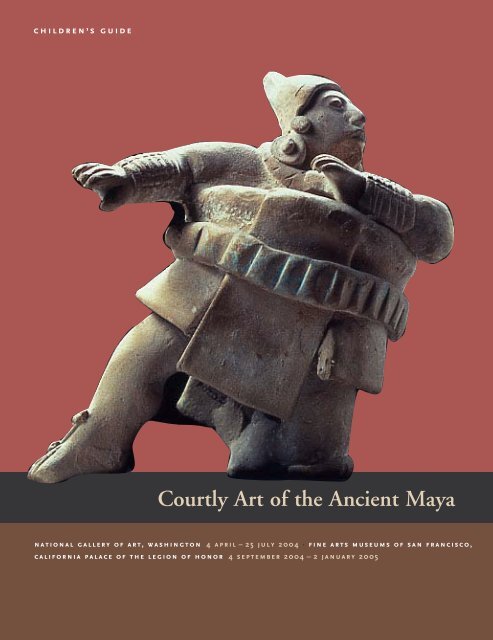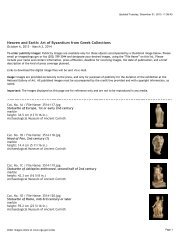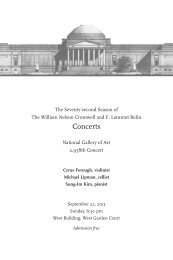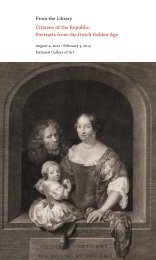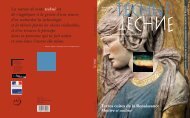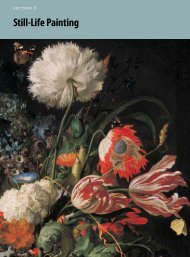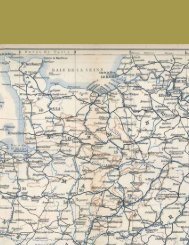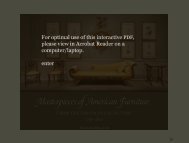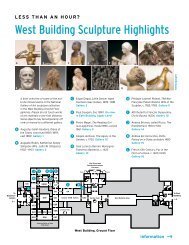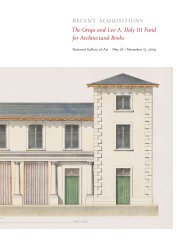Courtly Art of the Ancient Maya - National Gallery of Art
Courtly Art of the Ancient Maya - National Gallery of Art
Courtly Art of the Ancient Maya - National Gallery of Art
You also want an ePaper? Increase the reach of your titles
YUMPU automatically turns print PDFs into web optimized ePapers that Google loves.
children’ s guide<br />
<strong>Courtly</strong> <strong>Art</strong> <strong>of</strong> <strong>the</strong> <strong>Ancient</strong> <strong>Maya</strong><br />
national gallery <strong>of</strong> art, washington 4 april – 25 july 2004 · fine arts museums <strong>of</strong> san francisco,<br />
california palace <strong>of</strong> <strong>the</strong> legion <strong>of</strong> honor 4 september 2004 – 2 january 2005
gulf <strong>of</strong><br />
mexico<br />
Palenque<br />
Tonina<br />
chiapas<br />
Jaina Island<br />
Piedras Negras<br />
Yaxchilan<br />
Bonampak<br />
campeche<br />
guatemala<br />
Guatemala City<br />
pacific ocean<br />
Mérida<br />
yucatan<br />
mexico<br />
Calakmul<br />
Tikal<br />
Mesoamerica<br />
Chichen Itza<br />
quintana<br />
roo<br />
belize<br />
Copan<br />
Belize City<br />
el salvador<br />
gulf <strong>of</strong><br />
honduras<br />
Cancun<br />
caribbean<br />
sea<br />
honduras
The <strong>Maya</strong><br />
They were artists, ma<strong>the</strong>maticians, and scribes, warriors,<br />
weavers, and astronomers. In <strong>the</strong> rainforests <strong>of</strong> Mesoamerica,<br />
<strong>the</strong>y built <strong>the</strong> most sophisticated civilization <strong>the</strong><br />
New World had ever seen. They developed a complex<br />
writing system, invented <strong>the</strong> idea <strong>of</strong> zero, and tracked<br />
<strong>the</strong> stars and planets more accurately than anyone else.<br />
Since European explorers first found <strong>the</strong> crumbling<br />
ruins <strong>of</strong> <strong>Maya</strong> cities in <strong>the</strong> sixteenth century, <strong>the</strong> <strong>Maya</strong><br />
have slowly given up <strong>the</strong>ir<br />
secrets. In this exhibition<br />
you will discover <strong>the</strong> <strong>Maya</strong>,<br />
too. You’ll see works <strong>the</strong>y<br />
made between about ad<br />
600 and 900, when <strong>the</strong>ir<br />
civilization was at its peak.<br />
Most <strong>of</strong> <strong>the</strong>m come from<br />
<strong>the</strong> courts <strong>of</strong> <strong>Maya</strong> kings.<br />
By about 1000, <strong>the</strong><br />
greatness <strong>of</strong> <strong>Maya</strong> civilization had passed. Five hundred<br />
years later, more than half <strong>the</strong> population died <strong>of</strong> new<br />
diseases brought by Spanish conquerors. But <strong>the</strong> <strong>Maya</strong><br />
people survived. Today some six million <strong>Maya</strong> live in<br />
Mexico and Central America—and probably a million<br />
more have settled in <strong>the</strong> United States. <strong>Maya</strong> culture is<br />
diverse and alive, rich with traditions from <strong>the</strong> past.<br />
Maybe you have <strong>Maya</strong> friends.<br />
1 · <strong>Maya</strong> woman carrying<br />
flowers through a<br />
market in Chichicastenango,<br />
Guatemala
oom 1<br />
Kings and Courts<br />
<strong>Ancient</strong> <strong>Maya</strong> society was organized into city-states ruled<br />
by kings. Cities traded with one ano<strong>the</strong>r and competed for<br />
precious goods like jade and <strong>the</strong> brilliant fea<strong>the</strong>rs <strong>of</strong> <strong>the</strong><br />
quetzal bird. They made treaties—or war. Fortunes rose<br />
and fell, but no city ever controlled <strong>the</strong> whole <strong>Maya</strong> world.<br />
The largest cities had sixty thousand people or more and<br />
hundreds <strong>of</strong> buildings. Temples and palaces were painted<br />
red and decorated with sculpture. Temple-pyramids rose<br />
thirty stories high.<br />
The <strong>Maya</strong> ruler was at <strong>the</strong> center <strong>of</strong> <strong>the</strong> city’s political,<br />
economic, and religious life. His role on earth mirrored<br />
<strong>the</strong> role <strong>of</strong> <strong>the</strong> gods. He styled his appearance to match <strong>the</strong><br />
corn god and wore ornaments made <strong>of</strong> jade and quetzal<br />
fea<strong>the</strong>rs. Green like <strong>the</strong> leaves <strong>of</strong> corn, <strong>the</strong>y symbolized fertility<br />
and wealth. When he donned ceremonial costumes<br />
and <strong>the</strong> masks <strong>of</strong> gods, <strong>the</strong> king not only looked like those<br />
gods—he became like <strong>the</strong>m.<br />
3<br />
2<br />
^ meet one <strong>of</strong> <strong>the</strong> most famous <strong>of</strong> all maya kings—<br />
<strong>the</strong> great Pakal from Palenque. This portrait was found<br />
buried under his tomb. Pakal became king in 615 when<br />
he was twelve years old and ruled until he died in 683—<br />
a very long life in ancient times. He and his sons turned<br />
Palenque into a splendid city.<br />
2 · Ruins <strong>of</strong> <strong>Maya</strong><br />
architecture at Palenque<br />
3 · Cylinder vase<br />
with lords and cloth,<br />
(“Fenton Vase”), Nebaj,<br />
Guatemala, 600–800,<br />
ceramic, Courtesy<br />
<strong>of</strong> <strong>the</strong> Trustees <strong>of</strong><br />
The British Museum<br />
4 · Portrait head <strong>of</strong><br />
Pakal, Palenque, Mexico,<br />
c. 650–683, stucco,<br />
Museo Nacional de<br />
Antropología–inah,<br />
México<br />
5 · Mask, Calakmul,<br />
Campeche, Mexico,<br />
600 – 800, jade with<br />
obsidian and shell,<br />
Museo Arqueológico de<br />
Campeche “Fuerte de<br />
San Miguel,”–inah,<br />
México<br />
4<br />
5
6 7 8 9<br />
The <strong>Maya</strong> court included many people beyond <strong>the</strong> royal<br />
family: attendants to <strong>of</strong>fer food and drink, servants with<br />
flysweeps and fans, singers, musicians, and entertainers.<br />
There were also priests, diplomats, and warriors. Hunchbacks<br />
and dwarfs were trusted advisers.<br />
^ <strong>the</strong>se figurines were found in tombs. Some are<br />
whistles or rattles. Perhaps <strong>the</strong>y were put in graves to<br />
serve or entertain <strong>the</strong> person buried <strong>the</strong>re, or maybe<br />
<strong>the</strong>y represent that person in life.<br />
Who’s who? See if you can identify:<br />
• a diplomat or trader who traveled to distant cities under<br />
hot sun or pelting rain<br />
• a ruler in heavy padding, contemplating <strong>the</strong> battle ahead<br />
• a priest in fea<strong>the</strong>red regalia<br />
• a trumpeter<br />
< A mask like this was placed over<br />
Pakal’s face in his tomb. Jade was more<br />
precious to <strong>the</strong> <strong>Maya</strong> than gold.<br />
maya beauty<br />
Have you noticed that <strong>Maya</strong> men<br />
and women—and gods—have a<br />
certain “look”? Their ideal <strong>of</strong> beauty<br />
was modeled on <strong>the</strong> corn god—<br />
youthful and fresh, strong. Long<br />
heads and flowing hair mimic <strong>the</strong><br />
corn plant. Parents gave <strong>the</strong>ir children’s<br />
heads this long tapering<br />
shape by pressing <strong>the</strong> skull<br />
between boards for a few days just<br />
after birth. It only took a short<br />
while because babies’ bones are<br />
s<strong>of</strong>t, but <strong>the</strong> effect lasted for life. It<br />
didn’t affect intelligence.<br />
The perfect <strong>Maya</strong> nose was<br />
large and sloped to <strong>the</strong> forehead;<br />
people used inserts to get <strong>the</strong> right<br />
pr<strong>of</strong>ile. Crossed eyes were also<br />
desirable. <strong>Maya</strong> parents probably<br />
trained <strong>the</strong>ir kids’ eyes to cross by<br />
hanging something in front <strong>of</strong> <strong>the</strong>ir<br />
noses! Teeth were filed down to<br />
points or even T-shapes and sometimes<br />
decorated with small inlays<br />
<strong>of</strong> colored stones.<br />
6 · Seated figurine <strong>of</strong><br />
a trumpet player, Jaina<br />
Island, Campeche,<br />
Mexico, 600–900,<br />
ceramic, Sainsbury<br />
Centre for Visual <strong>Art</strong>s,<br />
Robert and Lisa<br />
Sainsbury Collection,<br />
University <strong>of</strong> East Anglia<br />
7 · Standing figurine in<br />
a blue coat, probably a<br />
messenger or emissary,<br />
Jaina Island, Campeche,<br />
Mexico, 600–900,<br />
ceramic, Museo<br />
Nacional de Antropología–inah,<br />
México<br />
8 · Seated figurine on<br />
a throne, Jaina Island,<br />
Campeche, Mexico,<br />
600–900, ceramic,<br />
Princeton University<br />
<strong>Art</strong> Museum, gift <strong>of</strong><br />
Gillett G. Griffin<br />
9 · Standing figurine<br />
<strong>of</strong> a priest, Jaina Island,<br />
Campeche, Mexico,<br />
600–900, ceramic,<br />
The Metropolitan<br />
Museum <strong>of</strong> <strong>Art</strong>, The<br />
Michael C. Rockefeller<br />
Memorial Collection,<br />
Bequest <strong>of</strong> Nelson A.<br />
Rockefeller, 1979
oom 2<br />
The Gods and <strong>the</strong> <strong>Maya</strong><br />
The <strong>Maya</strong> saw all things as interconnected.<br />
The past and present. The<br />
earth, <strong>the</strong> sky, and <strong>the</strong> underworld.<br />
People, nature, and <strong>the</strong> gods. The<br />
<strong>Maya</strong> needed <strong>the</strong> gods, but <strong>the</strong> gods<br />
needed <strong>the</strong> <strong>Maya</strong> too. Every facet <strong>of</strong><br />
life—even a ball game—linked <strong>the</strong>m.<br />
The <strong>Maya</strong> worshiped dozens <strong>of</strong><br />
gods. Many could appear old or young,<br />
in human or animal form. Before we<br />
could read <strong>Maya</strong> writing we did not<br />
know <strong>the</strong>ir names; <strong>the</strong>y were called<br />
God A, God B, and so on. Some are<br />
still known that way. As you go through<br />
<strong>the</strong> exhibition, look for <strong>the</strong>se gods:<br />
10<br />
> scepter<br />
K’awiil (God K)<br />
was a god <strong>of</strong><br />
lightning and<br />
had one snake<br />
foot. Because he<br />
also was a protector<br />
<strong>of</strong> royal<br />
family lines, he<br />
<strong>of</strong>ten decorates<br />
kings’ scepters.<br />
< vase <strong>of</strong> 7 gods<br />
Ruthless God L<br />
was a prince <strong>of</strong> <strong>the</strong><br />
underworld and<br />
a god <strong>of</strong> commerce<br />
and trade. He’s<br />
prosperous and<br />
smokes a cigar.<br />
Like <strong>Maya</strong> kings<br />
he sits on a jaguar<br />
pelt. Look for <strong>the</strong><br />
fea<strong>the</strong>red headdress<br />
where his messenger<br />
owl nests.<br />
11<br />
Chak Chel was <strong>the</strong> patron <strong>of</strong> women,<br />
a weaver (with cotton skeins tied in<br />
her hair) but also a warrior. Her name<br />
means “Great Rainbow,” but don’t<br />
think that is a lucky omen—<strong>the</strong><br />
<strong>Maya</strong> saw rainbows as dangerous signs<br />
from <strong>the</strong> underworld.<br />
> vase with<br />
moon goddess<br />
Women also<br />
prayed to a<br />
beautiful young<br />
moon goddess.<br />
You’ll find her<br />
sitting in <strong>the</strong><br />
curve <strong>of</strong> a crescent<br />
moon,<br />
12<br />
holding a rabbit. The <strong>Maya</strong> don’t<br />
see a man in <strong>the</strong> moon—<strong>the</strong>y see a<br />
rabbit. So do o<strong>the</strong>r people in Mesoamerica,<br />
Native Americans <strong>of</strong> <strong>the</strong><br />
southwestern United States, and<br />
<strong>the</strong> Chinese and Japanese. Next time<br />
<strong>the</strong> moon is full, look again!<br />
> maize god<br />
No god was more important<br />
to <strong>the</strong> <strong>Maya</strong> than <strong>the</strong> maize<br />
god, <strong>the</strong> god <strong>of</strong> corn.<br />
Always handsome and<br />
young, he danced<br />
when <strong>the</strong> breeze rustled<br />
his long leaves. Corn’s<br />
cycle <strong>of</strong> planting,<br />
growth, harvesting,<br />
and replanting is<br />
<strong>the</strong> cycle <strong>of</strong> life<br />
itself—birth,<br />
death, rebirth.<br />
13<br />
10 · Cylinder vessel<br />
with underworld scene<br />
(“Vase <strong>of</strong> <strong>the</strong> Seven<br />
Gods”), Naranjo region,<br />
Guatemala or Belize,<br />
755 – 784, ceramic,<br />
Anonymous loan,<br />
courtesy <strong>of</strong> The <strong>Art</strong><br />
Institute <strong>of</strong> Chicago<br />
11 · Scepter <strong>of</strong> K’awiil,<br />
provenance unknown,<br />
600–900, white stone,<br />
probably albite, Princeton<br />
University <strong>Art</strong><br />
Museum. Museum purchase,<br />
Fowler McCormick,<br />
Class <strong>of</strong> 1921, Fund<br />
it’s amaizing!<br />
12 · Cylinder vessel<br />
with Itzamna, Moon<br />
Goddess, and scribe,<br />
detail, Mexico or<br />
Guatemala, 700–800,<br />
ceramic, Virginia<br />
Museum <strong>of</strong> Fine <strong>Art</strong>s,<br />
Richmond. The Adolph<br />
D. and Wilkins C.<br />
Williams Fund<br />
13 · Maize God, Temple<br />
22, Copan, Honduras,<br />
680–750, volcanic tuff,<br />
Courtesy <strong>of</strong> <strong>the</strong> Trustees<br />
<strong>of</strong> The British Museum<br />
In <strong>the</strong> United States we call it corn,<br />
but <strong>the</strong> rest <strong>of</strong> <strong>the</strong> world knows it<br />
as maize. For <strong>the</strong> <strong>Maya</strong> it was literally<br />
<strong>the</strong> stuff <strong>of</strong> life—<strong>the</strong>y believed<br />
<strong>the</strong> first people had been created<br />
from corn. Corn needed humans as<br />
well—to tend it and plant it. Corn<br />
cannot seed itself <strong>the</strong> way many<br />
o<strong>the</strong>r plants can.<br />
Corn was <strong>the</strong> <strong>Maya</strong>’s most<br />
important food, and it’s still fundamental<br />
to <strong>the</strong> diet <strong>of</strong> people in<br />
Mesoamerica. Before being<br />
ground to a paste, <strong>the</strong> kernels<br />
are soaked to make <strong>the</strong>m<br />
more nutritious, a process<br />
called (here is a word to<br />
impress and “amaize” your<br />
friends) nixtimalization.<br />
The ancient people <strong>of</strong><br />
Mesoamerica learned<br />
this secret thousands<br />
<strong>of</strong> years ago. We<br />
know <strong>the</strong> <strong>Maya</strong> ate<br />
tamales—sometimes with iguana<br />
meat!—and maybe tortillas too.
The <strong>Maya</strong> Ball Game<br />
14 15<br />
Ballcourts are found in <strong>the</strong> center <strong>of</strong> nearly every <strong>Maya</strong><br />
city. As in soccer, players had to keep <strong>the</strong> ball in <strong>the</strong> air<br />
without using <strong>the</strong>ir hands. The ball was solid rubber and<br />
weighed eight pounds or more (that’s at least eight times a<br />
soccer ball). No wonder players wore heavy padding!<br />
In parts <strong>of</strong> Mexico and Central America a version <strong>of</strong><br />
<strong>the</strong> ancient game is still played. But for <strong>the</strong> ancient <strong>Maya</strong><br />
<strong>the</strong> stakes were especially high. Although it was played for<br />
sport, <strong>the</strong> game was also a mythic struggle. It reenacted<br />
contests <strong>of</strong> life and death, war, and sacrifice.<br />
16<br />
14 · Figurine <strong>of</strong> a<br />
ballplayer, Jaina Island,<br />
Campeche, Mexico,<br />
600–900, ceramic,<br />
Museo Nacional de<br />
Antropología–inah,<br />
México<br />
15 · Figurine <strong>of</strong> a<br />
ballplayer, Jaina Island,<br />
Campeche, Mexico,<br />
600–900, ceramic,<br />
Museo Nacional de<br />
Antropología–inah,<br />
México<br />
16 · Ballcourt at Copan,<br />
Honduras<br />
<strong>the</strong> hero twins play ball<br />
Some myths have survived in <strong>the</strong><br />
Popol Vuh, a text that recounts<br />
<strong>the</strong> <strong>Maya</strong> story <strong>of</strong> creation. It was<br />
translated into Spanish about 1700,<br />
but <strong>the</strong> stories it tells are much<br />
more ancient.<br />
The Hero Twins, Hunahpu<br />
and Xbalanque (pronounced “shaw<br />
bal an kay”), were excellent ballplayers.<br />
Unfortunately, <strong>the</strong> noise<br />
<strong>of</strong> <strong>the</strong>ir incessant games disturbed<br />
<strong>the</strong> gods <strong>of</strong> <strong>the</strong> underworld.<br />
Irritated, <strong>the</strong> gods sent a messenger<br />
owl to summon <strong>the</strong>m. Every<br />
day <strong>the</strong> twins played ball against<br />
<strong>the</strong> gods, just managing to hold<br />
<strong>the</strong>ir own. A good thing, since a<br />
loss would cost <strong>the</strong>m <strong>the</strong>ir lives!<br />
Each night <strong>the</strong>y faced o<strong>the</strong>r dangers<br />
in <strong>the</strong> houses where <strong>the</strong>y slept: <strong>the</strong><br />
Dark House, Razor House, Jaguar<br />
House. They escaped with cunning<br />
and <strong>the</strong> help <strong>of</strong> forest creatures—<br />
until <strong>the</strong> night in <strong>the</strong> Bat House,<br />
where snatcher bats flew. The boys<br />
slept inside <strong>the</strong> tubes <strong>of</strong> <strong>the</strong>ir blowguns<br />
for protection, but Hunahpu<br />
stuck his head out too soon and<br />
was decapitated. The next day,<br />
<strong>the</strong> gods used Hunahpu’s head in<br />
place <strong>of</strong> <strong>the</strong> ball. Xbalanque was<br />
able to trick <strong>the</strong>m, however, and<br />
reunite his bro<strong>the</strong>r’s head and<br />
body. In <strong>the</strong> end, it was <strong>the</strong> gods<br />
who lost that game.
^ courts were marked<br />
with three flat stones down<br />
<strong>the</strong> middle, probably scoring markers<br />
—also passages to <strong>the</strong> underworld. Look closely at <strong>the</strong><br />
ball this player is hitting <strong>of</strong>f his hip. It’s engraved with a<br />
human head. Hunahpu! That might lead you to believe<br />
that <strong>the</strong> ball player is one <strong>of</strong> <strong>the</strong> underworld gods. But<br />
<strong>the</strong> inscription gives an earthly date—May 19, 591. So, <strong>the</strong><br />
player is really a ruler acting out <strong>the</strong> Hero Twins’ game<br />
in a ritual that tied <strong>the</strong> human and supernatural worlds.<br />
numbers<br />
17 · Ballcourt marker,<br />
La Esperanza, Chiapas,<br />
Mexico, 591, limestone,<br />
Museo Nacional de<br />
Antropología–inah,<br />
México<br />
The <strong>Maya</strong> wrote <strong>the</strong>ir numbers using a dot for 1 and a<br />
bar for 5. Zero was a shell shape.<br />
0 1 4 6 19<br />
For larger numbers, <strong>the</strong>y used place notation just as we<br />
do, except that <strong>the</strong> <strong>Maya</strong> positioned <strong>the</strong> numbers vertically<br />
and horizontally and used base-20 where we use base-10.<br />
The <strong>Maya</strong> wrote…<br />
22 as that’s one 20 + 2 ones<br />
49 as that’s two 20s + 9 ones<br />
86 as ______________ you figure out this one!<br />
Now that you know <strong>the</strong> system, can you find <strong>the</strong> numbers<br />
on <strong>the</strong> ballcourt marker? Because <strong>the</strong> <strong>Maya</strong> recorded so<br />
many dates you’ll find numbers on lots <strong>of</strong> <strong>the</strong> objects in<br />
this exhibition.<br />
room 3<br />
<strong>Maya</strong> Women<br />
Women were more prominent in <strong>Maya</strong><br />
society than in many o<strong>the</strong>r ancient<br />
cultures. A few even ruled as queens.<br />
18 · Figurine <strong>of</strong> a woman<br />
preparing food, Jaina Island,<br />
Campeche, Mexico, 600–900,<br />
ceramic, Yale University <strong>Art</strong><br />
<strong>Gallery</strong>, Stephen Carlton Clark,<br />
B.A. 1903, Fund<br />
Women ran <strong>the</strong> home as mo<strong>the</strong>rs,<br />
nurses, and cooks. In addition to corn, <strong>the</strong>y prepared<br />
several kinds <strong>of</strong> beans and squash, various meats, and fish.<br />
v women contributed to <strong>the</strong> wealth <strong>of</strong> maya cities<br />
as spinners and weavers. Beautiful fabrics were even<br />
exchanged as luxury gifts between royal households.<br />
Weaving fine cotton cloth would have been one <strong>of</strong> a royal<br />
woman’s main occupations.<br />
<strong>Ancient</strong> <strong>Maya</strong> women wove on backstrap looms. The<br />
long threads <strong>of</strong> <strong>the</strong> warp were fixed to a beam that was<br />
looped around <strong>the</strong> weaver’s back. It was a simple device<br />
she could use nearly anywhere. <strong>Maya</strong> women today<br />
are still known for <strong>the</strong>ir skill in weaving, and <strong>the</strong>y still<br />
use <strong>the</strong> backstrap loom.<br />
19 · Figurine <strong>of</strong> a<br />
woman at her loom,<br />
Jaina Island, Campeche,<br />
Mexico, 600–900,<br />
ceramic, Museo<br />
Nacional de Antropología–inah,<br />
México
Ritual Roles<br />
One <strong>of</strong> <strong>the</strong> most important roles for royal women was<br />
in ritual. To contact and care for gods and ancestors,<br />
queens <strong>of</strong>fered <strong>the</strong>ir blood, just as <strong>the</strong>ir husbands did.<br />
Meeting <strong>the</strong> gods’ needs was <strong>the</strong> royal family’s greatest<br />
responsibility. Everything depended on it: rainfall and<br />
crops, <strong>the</strong> universe itself.<br />
> <strong>the</strong>se reliefs, from yaxchilan, show Lady Xok<br />
(pronounced “shoke”) and her husband Shield Jaguar,<br />
one <strong>of</strong> Yaxchilan’s greatest kings.<br />
Above, Lady Xok performs a sacrifice by pulling a<br />
thorny rope through her tongue. Her blood falls in drops<br />
and is collected by small bits <strong>of</strong> paper in <strong>the</strong> bowl at her<br />
feet. Shield Jaguar holds a torch to light <strong>the</strong> nighttime ritual.<br />
Below, <strong>the</strong> blood-soaked papers are burned, <strong>the</strong> smoke<br />
rising to <strong>the</strong> gods. In reward, <strong>the</strong>y send Lady Xok a vision<br />
—a serpent, with a warrior emerging from its mouth.<br />
Her sacrifice created a bond with <strong>the</strong> supernatural, not<br />
just for <strong>the</strong> queen and her family but for all <strong>the</strong> people<br />
<strong>of</strong> Yaxchilan.<br />
maya names: lady xok and shield jaguar<br />
Look for <strong>the</strong> names <strong>of</strong> Lady Xok and Shield Jaguar in <strong>the</strong><br />
inscriptions. Shield Jaguar is a name researchers gave<br />
<strong>the</strong> king before <strong>the</strong>y could read <strong>the</strong> ancient <strong>Maya</strong>n language.<br />
It describes what <strong>the</strong> signs look like but does<br />
not tell us what <strong>the</strong> king’s name sounded like. Now we<br />
know he was called Itzammaaj Balam. “Balam” was <strong>the</strong><br />
<strong>Maya</strong> word for jaguar.<br />
Lady Xok Shield Jaguar<br />
20 · Bloodletting ritual<br />
<strong>of</strong> Lady Xok (Lintel 24),<br />
Structure 23, Yaxchilan,<br />
Chiapas, Mexico, c. 725,<br />
limestone, Courtesy<br />
<strong>of</strong> <strong>the</strong> Trustees <strong>of</strong><br />
The British Museum<br />
20<br />
21<br />
21 · Lady Xok conjuring<br />
a giant serpent (Lintel<br />
25), Structure 23, Yaxchilan,<br />
Chiapas, Mexico,<br />
c. 725, limestone,<br />
Courtesy <strong>of</strong> <strong>the</strong> Trustees<br />
<strong>of</strong> The British Museum
oom 4<br />
Writing and <strong>the</strong> <strong>Art</strong>s<br />
The ancient <strong>Maya</strong> wanted history to know who <strong>the</strong>y were.<br />
They recorded <strong>the</strong>ir names and <strong>the</strong>ir deeds. But since <strong>the</strong><br />
Spanish conquest <strong>the</strong> <strong>Maya</strong> remained anonymous, because<br />
we could not read <strong>the</strong>ir writing. We could not learn <strong>the</strong>ir<br />
names or histories. The decoding <strong>of</strong> <strong>Maya</strong> writing in <strong>the</strong><br />
last fifty years has been a triumph <strong>of</strong> modern archaeology.<br />
It reintroduces us to real people and events.<br />
Instead <strong>of</strong> using an alphabet, <strong>the</strong> <strong>Maya</strong> wrote with<br />
signs called hieroglyphs. Some are pictures that stand for<br />
whole words, o<strong>the</strong>rs for <strong>the</strong> sounds <strong>of</strong> syllables. Take <strong>the</strong><br />
word “jaguar,” for example. It could be written two ways.<br />
balam<br />
ba la<br />
m(a)<br />
How many <strong>Maya</strong> could read and write? Probably only<br />
those at <strong>the</strong> top <strong>of</strong> society. There were pr<strong>of</strong>essional writers,<br />
called scribes, but even some princes decorated and wrote<br />
on vases. It’s possible that all <strong>the</strong> boys in noble families<br />
learned at least <strong>the</strong> basics <strong>of</strong> writing—some scratched<br />
graffiti on palace walls. Did women learn to read and<br />
write too? We’re not yet sure.<br />
> this scribe is poised with a brush and an inkpot<br />
made <strong>of</strong> a sliced shell. He is not <strong>the</strong> <strong>Maya</strong> ideal <strong>of</strong> beauty<br />
—he resembles <strong>the</strong> mythical patrons <strong>of</strong> writing, <strong>the</strong><br />
Monkey Twins. They were <strong>the</strong> older half-bro<strong>the</strong>rs <strong>of</strong> <strong>the</strong><br />
Hero Twins and <strong>the</strong> masters <strong>of</strong> all kinds <strong>of</strong> arts. As <strong>the</strong><br />
Popol Vuh says, “all <strong>the</strong>y do is play and sing, all <strong>the</strong>y<br />
work at is writing and carving, every day, and this cheers<br />
<strong>the</strong> heart <strong>of</strong> <strong>the</strong>ir grandmo<strong>the</strong>r.” The story goes on:<br />
Although talented, <strong>the</strong> Monkey Twins tormented <strong>the</strong>ir<br />
younger bro<strong>the</strong>rs mercilessly. Originally <strong>the</strong>y were boys<br />
just like <strong>the</strong> Hero Twins. But one day, <strong>the</strong> pair climbed<br />
too high in a tree, greedily eating fruit, and were unable<br />
to get down. They asked <strong>the</strong>ir younger bro<strong>the</strong>rs for help.<br />
Revenge! The Hero Twins rescued <strong>the</strong>ir bro<strong>the</strong>rs by giving<br />
<strong>the</strong>m tails and turning <strong>the</strong>m into monkeys who easily<br />
scampered to <strong>the</strong> ground.<br />
Most <strong>Maya</strong> writing that survives is on stone monuments<br />
and pottery. It is only a fraction <strong>of</strong> what once<br />
existed. The <strong>Maya</strong> wrote books too, just as <strong>the</strong> Monkey<br />
Twins do on <strong>the</strong> vase above. The books were made <strong>of</strong><br />
folded bark pages, with jaguar skin covers. Today only four<br />
survive, and <strong>the</strong>y were written much later, about <strong>the</strong> time<br />
<strong>of</strong> <strong>the</strong> Spanish conquest.<br />
22 · Cylinder vessel<br />
with Monkey Scribes<br />
(Monkey Twins),<br />
Mexico or Guatemala,<br />
700–800, ceramic,<br />
New Orleans Museum<br />
<strong>of</strong> <strong>Art</strong>: Museum<br />
purchase, Women's<br />
Volunteer Committee<br />
Fund and Anonymous<br />
Funds<br />
23 · Sculpture <strong>of</strong> a scribe,<br />
Copan, Honduras,<br />
650–800, stone,<br />
Instituto Hondureño de<br />
Antropología e Historia<br />
23<br />
22
^ <strong>the</strong>se are mysterious objects. No one knows what<br />
<strong>the</strong>y were used for. They were buried under buildings<br />
and large sculpture. Their strange shapes—razor sharp<br />
and impossible to hold—were formed by chipping <strong>the</strong><br />
hard stone, flint. Many look like faces. Do you see <strong>the</strong>m?<br />
It might be K’awiil, <strong>the</strong> god <strong>of</strong> lightning. If you strike<br />
flint against a rock, it will spark. Easy to see why <strong>the</strong> <strong>Maya</strong><br />
believed flint was formed when lightning hit <strong>the</strong> earth.<br />
Try sketching <strong>the</strong> faces here:<br />
24 · Eccentric flint with<br />
human faces, El Palmar,<br />
Quintana Roo, Mexico,<br />
711, flint, Museo<br />
Nacional de Antropología–inah,<br />
México<br />
25 · Cylinder vessel<br />
with flower motifs<br />
(“Fleur-de-lis vase”),<br />
Naranjo region, Guatemala<br />
or Belize, c. 780,<br />
ceramic, The <strong>Art</strong> Institute<br />
<strong>of</strong> Chicago, E<strong>the</strong>l T.<br />
Scarborough Fund<br />
really hot chocolate<br />
The <strong>Maya</strong> labeled <strong>the</strong>ir pottery with <strong>the</strong>ir names and<br />
what it was used for. This cup, and ones like it, held<br />
one <strong>of</strong> <strong>the</strong> <strong>Maya</strong>’s favorite drinks—chocolate. But it<br />
was not cocoa as we know it. It was bitter and spiced<br />
with hot chilies!<br />
v try this recipe. You can sweeten it if you like with<br />
honey. (The <strong>Maya</strong> kept bees—stingless bees!)<br />
1 oz <strong>of</strong> unsweetened baking chocolate<br />
2/3 cup boiling water<br />
ground chili peppers (as much as you dare)<br />
Grate <strong>the</strong> chocolate and melt it in a bowl with a little <strong>of</strong><br />
<strong>the</strong> boiling water. Mix it well, <strong>the</strong>n add <strong>the</strong> o<strong>the</strong>r ingredients.<br />
Let <strong>the</strong> drink cool and beat it to a frothy mixture.<br />
ca<br />
Cacao<br />
u(a)<br />
ca<br />
< look for this glyph.<br />
It means cacao. Cacao,<br />
from which chocolate<br />
is made, was not just<br />
valuable as food. It<br />
was used as money!<br />
Counterfeiters even<br />
faked <strong>the</strong> dried beans<br />
with clay imitations.
oom 5<br />
War<br />
War was a part <strong>of</strong> <strong>Maya</strong> life too, and military leadership a<br />
responsibility <strong>of</strong> <strong>the</strong> king and court. <strong>Maya</strong> cities fought to<br />
obtain valuable resources and to win control over smaller,<br />
weaker neighbors.<br />
> warriors were armed with flint-tipped weapons<br />
and protected by lea<strong>the</strong>r vests and padding. They carried<br />
shields and wore helmets decorated with jaguars and<br />
o<strong>the</strong>r fierce creatures to share <strong>the</strong>se animals’ power. Battle<br />
was a noisy affair, accompanied by drums and loud horns.<br />
v captives were marched to <strong>the</strong> victorious city<br />
and forced to kneel before <strong>the</strong> king and his <strong>of</strong>ficers.<br />
They were stripped <strong>of</strong> <strong>the</strong>ir finery and tied with ropes.<br />
Torn cloth replaced <strong>the</strong>ir large jade earrings. Some<br />
prisoners were forced to play a deadly ritual ball game<br />
<strong>the</strong>y had no hope <strong>of</strong> winning—or surviving.<br />
Yet, <strong>the</strong> <strong>Maya</strong> pictured captives with dignity and<br />
carefully recorded <strong>the</strong>ir names. Capture <strong>of</strong> a prince or king<br />
was greatly prized. This prisoner was a king <strong>of</strong> Palenque<br />
and son <strong>of</strong> Pakal. He was captured by nearby Tonina. His<br />
fate is unclear, but recent evidence suggests that he<br />
returned to Palenque. Maybe he was ransomed or made<br />
a subject king. Unlike most captives, he has kept most <strong>of</strong><br />
his jewelry.<br />
26 · Carved panel with<br />
warrior, Chiapas,<br />
Mexico, 864, limestone,<br />
Private collection<br />
27 · Relief carving <strong>of</strong><br />
captive King K’an Hoy<br />
Chitam <strong>of</strong> Palenque<br />
(Monument 122),<br />
Tonina, Chiapas, Mexico,<br />
711, limestone, Museo<br />
Regional de Chiapas–<br />
inah, México<br />
26<br />
27
oom 6<br />
Archaeology<br />
In <strong>the</strong> eighteenth century, Palenque was <strong>the</strong> first <strong>Maya</strong><br />
city to reemerge from <strong>the</strong> tangle and mists <strong>of</strong> <strong>the</strong> highcanopy<br />
rainforest. It captures <strong>the</strong> imagination <strong>of</strong> visitors,<br />
not to mention <strong>the</strong> dedication <strong>of</strong> scholars who continue<br />
to learn its secrets.<br />
v work continues not only at palenque, but at <strong>Maya</strong><br />
sites all over Mesoamerica. Teams include many different<br />
specialists—archaeologists who painstakingly uncover<br />
monuments buried under layers <strong>of</strong> forest and rubble,<br />
epigraphers who study inscriptions, and conservators<br />
who care for artifacts. O<strong>the</strong>r scientists research plant and<br />
animal life and <strong>the</strong> interaction <strong>of</strong> people and <strong>the</strong> environment.<br />
<strong>Art</strong>ists copy inscriptions and draw objects, even<br />
in <strong>the</strong> age <strong>of</strong> digital photography, while new imaging<br />
technology lets excavators “see” underground.<br />
28 · The mists <strong>of</strong><br />
Palenque<br />
29 · Archaeologists at<br />
work in Palenque<br />
29<br />
chiclets and<br />
maya archaeology<br />
In 1871 <strong>the</strong> first chewing gum<br />
factory opened in New York. The<br />
new candy, “snappy and stretchy”<br />
and so much better than <strong>the</strong><br />
flavored wax people had chewed<br />
before, was hugely popular. It<br />
also played a surprising part in<br />
<strong>the</strong> rediscovery <strong>of</strong> <strong>Maya</strong> civilization.<br />
Gum is made from chicle,<br />
which was collected from trees<br />
in <strong>the</strong> jungles <strong>of</strong> Mesoamerica.<br />
Roads cut through <strong>the</strong> dense forest<br />
to make transportation easier<br />
led explorers to ancient cities lost<br />
for centuries.<br />
28
^ this relief, which was probably part <strong>of</strong> a throne,<br />
was found in 2002, as Mexican archaeologists worked to<br />
clear rubble from a temple in Palenque. Although it was in<br />
many pieces, careful excavation managed to recover almost<br />
all <strong>of</strong> it. It looks small here, but it is actually seven-and-ahalf<br />
feet long.<br />
Try This!<br />
number, please<br />
Try writing your phone number using <strong>the</strong> <strong>Maya</strong> method.<br />
Write a friend’s phone number here.<br />
Write ano<strong>the</strong>r friend’s phone number here.<br />
30<br />
30 · Front <strong>of</strong> <strong>the</strong> royal<br />
platform <strong>of</strong> King Ahkal<br />
Mo’ Nahb, Temple 21,<br />
Palenque, Chiapas,<br />
Mexico, 736, limestone,<br />
Museo de Sitio de<br />
Palenque “Dr. Alberto<br />
Ruz L’Huillier”–inah,<br />
México<br />
a<br />
e<br />
i<br />
o<br />
u<br />
b ch<br />
> Now write your name, using<br />
this chart. It is a simplified<br />
version <strong>of</strong> a <strong>Maya</strong> syllabary.<br />
Complete syllabaries are much<br />
more complex. Use one glyph<br />
for each syllable. Not all <strong>of</strong> <strong>the</strong><br />
sounds <strong>of</strong> English exist in<br />
<strong>Maya</strong>n languages, so you may<br />
have to improvise. Wondering<br />
about <strong>the</strong> empty boxes on <strong>the</strong><br />
chart? They are discoveries still<br />
waiting to be made!<br />
You could make an entire<br />
<strong>Maya</strong> telephone directory<br />
<strong>of</strong> your friends.
h k l m n p s t tz w x y
Books for Kids<br />
Laurie Coulter, Secrets in Stone: All about<br />
<strong>Maya</strong> Hieroglyphs. Boston: Little, Brown and<br />
Company, 2001.<br />
Rachel Crandell, Hands <strong>of</strong> <strong>the</strong> <strong>Maya</strong>: Villagers<br />
at Work and Play. New York: Henry Holt and<br />
Company, 2002.<br />
Peter Lourie, The Mystery <strong>of</strong> <strong>the</strong> <strong>Maya</strong>:<br />
Uncovering <strong>the</strong> Lost City <strong>of</strong> Palenque. Honesdale,<br />
Pa.: Boyds Mill Press, 2001.<br />
Dorothy Rhoads, The Corn Grows Ripe. New<br />
York: Puffin Books, 1993.<br />
Marc Talbert, Heart <strong>of</strong> a Jaguar. New York: Simon<br />
and Schuster Books for Young Readers, 1995.<br />
web sites<br />
Try <strong>the</strong>se Web sites. You can play a virtual<br />
ball game, see <strong>the</strong> latest information from<br />
archaeologists at Palenque, figure your birthday<br />
in <strong>the</strong> <strong>Maya</strong> calendar, see and hear glyphs—<br />
even match wits with <strong>the</strong> Hero Twins.<br />
Mesoweb.org<br />
Ballgame.org<br />
Famsi.org<br />
Half-moon.org<br />
Lady Xok glyph: Drawing courtesy <strong>of</strong> <strong>the</strong> Peabody Museum <strong>of</strong> Archaeology and<br />
Ethnography, Harvard University; Shield Jaguar glyph and Balam logograph and<br />
phonetic: reproduced from David Drew, The Lost Chronicle <strong>of</strong> <strong>the</strong> <strong>Maya</strong>n Kings<br />
(University <strong>of</strong> California Press, 1999), 159, 169; Cacao glyph: Reprinted from David<br />
Stuart, “The Rio Azul Cacao Pot: Epigraphic Observations on <strong>the</strong> Function <strong>of</strong> a <strong>Maya</strong><br />
Ceramic Vessel,” Antiquity 62: 153–157, fig. 2; Glyph chart: Adapted from Laurie<br />
Coulter, Secrets in Stone: All about <strong>Maya</strong> Hieroglyphs (Litttle, Brown and Company,<br />
2001), 44, 45.<br />
photo credits<br />
1: © Anna Clopet/corbis; 2: © ML Sinibaldi/corbis; 3, 13, 20, 21, 22, 23:<br />
© Justin Kerr; 4, 5, 7, 14, 15, 19, 30: © Michel Zabé; 6: James Austin; 8, 11:<br />
Bruce M. White; 9: Photograph © 1981 The Metropolitan Museum <strong>of</strong> <strong>Art</strong>;<br />
10: © Justin Kerr (K2796); 12: © Justin Kerr (K504); 16: Craig Lovell/corbis;<br />
17, 18, 24: Jorge Pérez de Lara; 25: © Justin Kerr (K635); 27: © Photo Javier<br />
Hinojosa; 28, 29: Photography courtesy Roger Sherman © 2003<br />
<strong>Courtly</strong> <strong>Art</strong> <strong>of</strong> <strong>the</strong> <strong>Ancient</strong> <strong>Maya</strong> has been organized by<br />
<strong>the</strong> <strong>National</strong> <strong>Gallery</strong> <strong>of</strong> <strong>Art</strong>, Washington, and <strong>the</strong> Fine <strong>Art</strong>s<br />
Museums <strong>of</strong> San Francisco.<br />
The exhibition at <strong>the</strong> <strong>National</strong> <strong>Gallery</strong> <strong>of</strong> <strong>Art</strong><br />
is made possible by a generous grant from <strong>the</strong><br />
Ca<strong>the</strong>rine B. Reynolds Foundation.<br />
Televisa, <strong>the</strong> largest media group in <strong>the</strong> Spanishspeaking<br />
world, proudly sponsors this exhibition<br />
as part <strong>of</strong> its commitment to promote and share<br />
its Mexican heritage.<br />
The exhibition is supported by an indemnity from <strong>the</strong> Federal<br />
Council on <strong>the</strong> <strong>Art</strong>s and <strong>the</strong> Humanities.<br />
This guide was written by Carla Brenner, prepared by <strong>the</strong> Division <strong>of</strong> Education,<br />
and produced by <strong>the</strong> Publishing Office. Our thanks to Bryan Just, Mary Miller, and<br />
Simon Martin. © 2004 Board <strong>of</strong> Trustees, <strong>National</strong> <strong>Gallery</strong> <strong>of</strong> <strong>Art</strong>, Washington<br />
Cover · Figurine <strong>of</strong> a<br />
ballplayer, Jaina Island,<br />
Campeche, Mexico,<br />
600–900, ceramic,<br />
Museo Nacional de<br />
Antropología—inah,<br />
México (no. 14)


